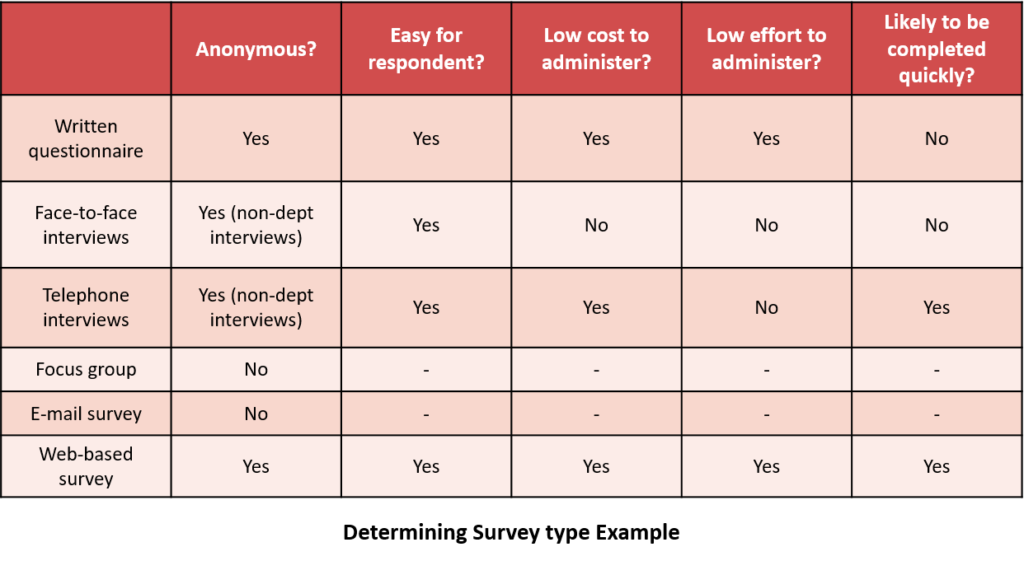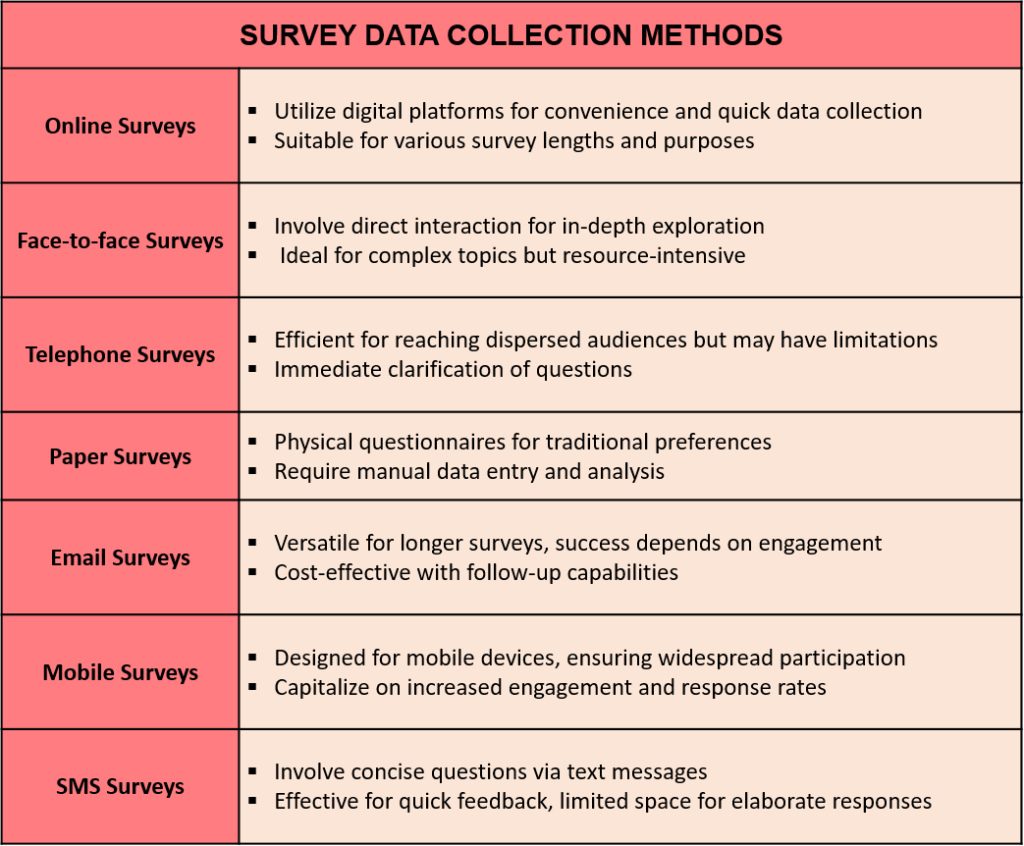In this data-driven age, gathering valuable information is crucial for businesses and organizations to make informed decisions. Surveys have proven to be a powerful tool for collecting data, providing valuable insights into consumer preferences, opinions, and behaviors. However, understanding when, why, and how to use surveys effectively can be a daunting task. That’s why we have compiled this complete guide to data collection surveys. Whether you are a seasoned researcher or just starting out, this comprehensive guide will walk you through the process of using surveys to gather valuable information. From choosing the right survey type and designing effective questions to analyzing and interpreting survey data, we will provide you with practical tips, strategies, and real-world examples to help you make the most out of your survey efforts. Get ready to unlock the potential of surveys and take your data collection to the next level!
TABLE OF CONTENTS:
- WHAT IS A DATA COLLECTION SURVEY?
- WHEN TO USE SURVEYS TO COLLECT DATA?
- BENEFITS OF SURVEYS
- SURVEY CONSIDERATIONS
- HOW TO ADMINISTER A SURVEY?
- DATA COLLECTION TYPES FOR SURVEYS
- SURVEY DATA COLLECTION METHODS
- SURVEY EXAMPLE
- CONCLUSION
1. WHAT IS A DATA COLLECTION SURVEY?
Also known as questionnaire, e-survey, telephone interview, face-to-face interview, focus group
Survey is a powerful data collection and analysis tool for organizations to gather valuable information from a specific target audience. It is a systematic approach to collecting data and insights through carefully designed questions. Surveys can be conducted online, through email, or even in person.
A data collection survey serves to gather both quantitative and qualitative data for informed decision-making. It finds applications in market research, customer satisfaction assessment, employee feedback, and academic research. A well-designed survey includes carefully crafted questions, either open-ended or closed-ended. Surveys are cost-effective, provide anonymity for honest responses, and allow for standardized comparisons across groups or time periods. Success depends on clear objectives, defining the target audience, and a well-thought-out questionnaire.
Proper survey design and administration are essential to ensure the quality and reliability of the collected data. In the next section, we will dive deeper into why you might want to use a data collection survey and provide examples of how surveys can be effectively used in different scenarios.
2. WHEN TO USE SURVEYS TO COLLECT DATA
- Identifies customer preferences and needs
- Assesses satisfaction for customers or employees
- Prioritizes and addresses problems effectively
- Evaluate changes before implementation
- Assesses success post-implementation
- Monitors satisfaction changes over time
- Conducts market research for trends
- Understands and fills market gaps
- Measures employee satisfaction and engagement
- Gathers feedback for product/service improvement
3. BENEFITS OF SURVEYS
- Provides insights into customer preferences and needs
- Identifies areas for improvement and problem solving
- Enhances decision making by evaluating proposed changes
- Measures and tracks customer or employee satisfaction over time
- Informs market strategies and product development
- Gathers valuable feedback on products, services, or events
- A confidential platform for employees to express opinions
- Facilitates positive changes within the organization
- Improves event planning and participant satisfaction
- Enhances overall understanding of stakeholders and target audiences
4. SURVEY CONSIDERATIONS
- Only conduct surveys if there is a commitment to act on the results.
- Compare satisfaction surveys with objective indicators for validation.
- Treat satisfaction surveys as ongoing processes, not one-time events.
- Investigate if survey results do not align with other performance measures.
- Seek assistance from research organizations for significant surveys.
- Ensure alignment between survey questions and actionable insights.
- Regularly review and update survey questions for relevance and clarity.
- Respect respondent privacy and ensure confidentiality for honest responses.
- Pilot test surveys before full deployment to identify and address issues.
- Communicate the purpose and potential impact of surveys to participants.
5. HOW TO ADMINISTER A SURVEY?

- Clearly define the objectives of the survey and how the results will be utilized.
- Identify the target population and, if necessary, determine a representative sample.
- Specify the demographic information needed for result analysis.
- Choose the most suitable survey type based on the goals and nature of the study.
- Determine the format of survey answers: numerical rating, ranking, yes-no, multiple choice, open-ended, or a mix.
- Brainstorm questions, especially for multiple choice, and consider possible answers.
- Streamline the question list to the essential minimum for obtaining the necessary information.
- Prepare the questionnaire or interviewer’s question list.
- Conduct a small group test to gather feedback on question clarity, redundancy, and answer choices.
- Assess whether respondents wanted to provide feedback on topics not covered (indicated by open ended questions).
- Evaluate the average time to complete the survey and check for errors in the questionnaire.
- Test the process of tabulating and analyzing data to ensure ease and completeness.
- Revise the survey based on test feedback and results.
- Administer the finalized survey.
- Tabulate and analyze the data, considering how to follow through with the findings.
- Report results and plans to all stakeholders, including the margin of error and confidence level if a sample was used.
6. DATA COLLECTION TYPES FOR SURVEYS
Survey data collection encompasses various types, each tailored to specific research needs. Let us explore these approaches to ensure accurate information gathering and informed decision-making.
- Primary Data Collection
Involves directly gathering information for a specific research study or project. Utilizes surveys, interviews, experiments, or observations to obtain fresh, tailored data aligned with research objectives. Allows researchers to control the process and engage directly with respondents, ensuring collected information meets unique study requirements.
- Secondary Data Collection
Comprises existing information collected by others for their purposes but repurposed by researchers. Includes sources like research papers, government statistics, or historical records. While not collected directly for the current study, this pre-existing data provides insights and reference material, saving time and resources.
- Quantitative Data Collection
Involves gathering numerical information for statistical analysis. Standard methods include surveys with closed-ended questions, numerical ratings, or measurements. Focuses on objective measurements, enabling more evident patterns or trends through numerical representation.
- Qualitative Data Collection
Involves obtaining non-numerical data for depth and context. Methods include interviews, open-ended survey questions, or focus groups. Emphasizes understanding behaviors, motivations, or perceptions, offering rich descriptive insights beyond numerical data analysis.
- Longitudinal Data Collection
Entails gathering information from the same subjects over an extended period. Tracks changes, developments, or trends within a specific population. Provides insights into patterns of change, continuity, or progression within a study group, offering valuable temporal insights in research.
7. SURVEY DATA COLLECTION METHODS
Survey data collection methods encompass various approaches that facilitate honest feedback and deeper understanding of your audience or research topic. Let’s explore the different types:

Each method offers unique advantages and considerations, allowing researchers to choose the most suitable approach based on their specific goals and target audience.
8. SURVEY EXAMPLE
Surveys are an incredibly valuable tool for collecting data and gathering insights from your target audience. Let’s take a look at an example of how a survey can be used effectively. Imagine you are a marketing manager for a skincare brand and you want to understand your customers’ preferences and habits better. You decide to create a survey to gather this information. Here’s an example of how you can structure your survey questions:
Skincare Preferences Questionnaire

9. CONCLUSION
In conclusion, data collection surveys are powerful tools for organizations to gather valuable insights from their target audiences. Through carefully designed questions, surveys enable the systematic collection of quantitative and qualitative data, allowing informed decision making across various domains such as market research, customer satisfaction assessment, and employee feedback. The benefits of surveys include providing insights into preferences, identifying areas for improvement, and enhancing decision making processes. A well-executed survey process contributes to organizational growth, improvement, and a deeper understanding of stakeholders and target audiences.
